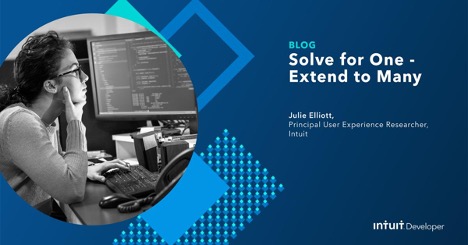
Recently, we shared the story of how and why Intuit® co-founder Scott Cook started Intuit’s ongoing “Follow Me Home” (FMH) program, the practice of watching customers use our products in their home (with their permission, of course) and asking questions about their experience. This peek into real-life use of our products provides firsthand knowledge of what does and does not work. We then use this information to improve the user experience.
Keep in mind that “customer” is not singular. Our goal is to build an inclusive experience, making our software accessible to any user, regardless of their abilities, via any device they require. Customer interviews through FMH reveal pain points, as well as opportunities to create solutions that not only solve for that individual, but for many others as well.
Improving the user experience through FMHs
The idea of watching someone in their home may sound awkward, but it’s really not. As long as you have an observable product or service, and your customer is willing to have an audience while they use it, it’s the ideal way to see exactly how it works and how the customer responds in their own environment.
Let’s look at an example of a FMH.
A customer reached out to us through our accessibility feedback mechanism with a problem she was having with TSheets, now known as QuickBooks® Time. She was very frustrated with not being able to put her availability in the schedule we provide, and had to email her boss each week in order to do her job.
We coordinated a FMH and began the virtual interview by using Intuit’s secret weapon: Design for Delight or D4D. What is D4D? It’s the idea of falling in love with the customer’s problem and not the solution. This means we first find out what problem or challenge a customer is facing through the FMH interview, which allows us to gain empathy for the customer and insight into what they’ve been dealing with. From there, we brainstorm ideas with the whole team, where we first go broad with many ideas, narrowing them down to the one that delivers the greatest customer benefit. We then test the idea or ideas internally before going externally.
During this FMH, we were able to see how she used her keyboard and JAWS, a screen reader, to navigate TSheets. During the hour we had with her, we could all feel and hear her frustration. She was trying to perform a simple job function—that everyone else in her office was able to perform—using a time-consuming workaround she created.
As a team, we discussed what was most important for her and how we could help her. We turned to our local accessibility team who audited and corrected the feature to remove our customer’s barrier so she could create her own schedule.
Success for one, success for many
When the feature was corrected, we met with our customer again to follow up. We wanted to teach her how to use the feature and ensure that it worked as expected … and it did.
She really appreciated that she could use our solution without having to email her boss. She was also excited when she found out she was able to pick her own color to show on the schedule. When we spoke with her during the first interview, we could hear in her voice that she wanted to be able to use the product like her co-workers, but she was also independent and justifiably proud of all the work she had done with computers. Being able to pick her own color allowed for her to still have some choice and independence—a great side benefit.
We originally set out to remove a barrier for one customer, but we found that many other users discovered they could now manage their schedule with a keyboard for the first time. The success for one became a success for more than 6,000 unique customers!
The customer’s journey was an incredible experience to see. From watching their struggle to creating a solution, their delight was extremely rewarding for our team. We were also pleasantly surprised when we saw how many other customers were able to find the solution. Intuit’s FMH and D4D practices, along with our continued search for accessibility feedback in Slack and setting priorities for accessibility issues, ensures that it will be an experience that happens over and over—as we work to quickly resolve barriers and provide our customers with innovative, inclusive products.
Interested in learning more about accessibility? Check out Why the Accessibility Tree is key to understanding accessible applications.
